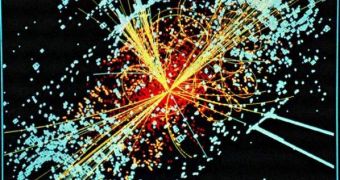Yesterday, the largest particle accelerator in the world managed to break the world record for producing the most energetic collisions ever achieved in such a machine. Granted, the Large Hadron Collider (LHC) broke its own record that it set in December, and analysts say that it will continue to set the bar higher and higher in the coming years, as its energy levels are gradually increased. Back in December 2009, the machine managed to exceed the 1.18 TeV (trillion electron volts) energy level, exceeding Fermilab's Tevatron accelerator. Now, it managed to reach a level of 3.5 TeV per beam, which places it well above all other accelerators in the world, the BBC News reports.
The Collider operates two beams of particles, each of them accelerated to the same energy level. They run counter-clockwise through the 27-kilometer-long tunnels of the accelerator, which is built some 100 meters underground, near the town of Geneva. The proton beams are accelerated to incredibly high speeds, almost reaching the speed of light, and are then collided head-on inside the three main particle detectors that dot the LHC tunnels. The energy of the proton beams dictates the amount and type of elementary particles that would be produced as the two collide at full speed.
On the morning of March 20, the team operating the accelerator boosted power levels to 3.5 TeV per beam, which means that collisions will soon begin to take place at a combined energy output of 7 TeV. Getting the beams to actually collide with each other will take some additional tweaking, but experts hope to begin conducting detection experiments at these energy levels this month or the next one. Given that the LHC has only been online for 5 months, and that it is one of the most complex scientific experiments ever devised, reaching the new energy level is a wonderful achievement.
“Getting the beams to 3.5 TeV is testimony to the soundness of the LHC's overall design, and the improvements we've made since the breakdown in September 2008. It's a great credit to the patience and dedication of the LHC operation team,” says the CERN director for accelerators and technology Steve Myers. The organization was in charge of building the accelerator, and is currently operating it. “We must not lose sight of the fact that the LHC is new, and it wasn't bought off the shelf,” he adds, in reference to the problems that the team trying to get the machine to work has faced over the past two years.

 14 DAY TRIAL //
14 DAY TRIAL //